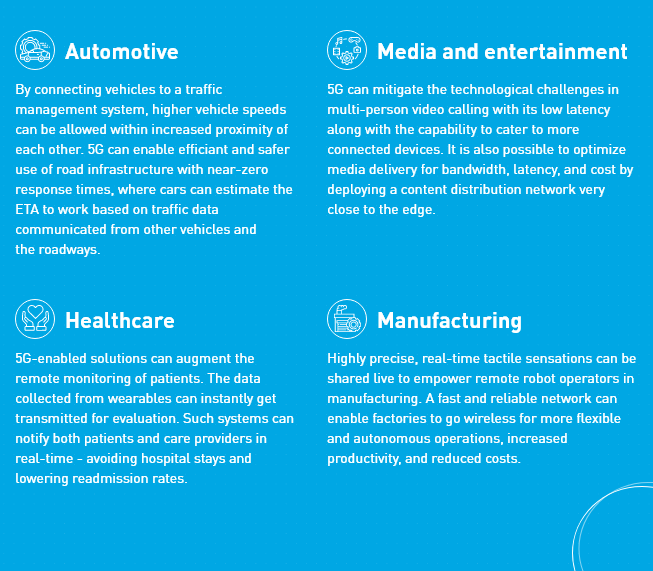While 1G introduced analog voice to mobile networking, 2G brought digital voice, which gave way to features like SMS and voicemail. 3G added higher mobile data transfer resulting in mobile web browsing, GPS location tracking, and image sharing. The advent of 4G marked the beginning of mobile internet with faster broadband for improved web functionality - enabling unprecedented quality of video streaming and on the go calling. But the increased data flow also led to network congestion.
Now, what can we expect from the fifth-generation of wireless communication? Ten times faster connection speed? High-resolution video calls? Or, unmatched download speed. The answer is all of these. And more.
| 3G
|
4G
|
5G
|
Deployment
| 2004-05
| 2006-10
| 2019-2020
|
Latency
| 100-500 milliseconds
| 20-30 milliseconds
| <10 milliseconds
|
Avg seed
| 144 kbps
| 25 Mbps
| 200-400 Mbps
|
Peak date rate
| 200 kbps
| 1 Gbps
| 20 Gbps
|
An end to congestion
5G is about executing thousands of machine-type transactions and efficiently using the radio spectrum across diverse operating environments. With its widespread connectivity, this extension of LTE and LTE-Advanced networks will unlock everything from smart wearables to high-definition AR and VR. It will drive economic growth, improved living standards, and more intelligent environments – apart from enabling better communication.
While the current network technologies operate like floodlights (illuminating an area but wasting a lot of energy), 5G uses Massive MIMO technologies (Multiple Input Multiple Output.) The 5G technology targets users around a cell site, thus improving coverage, speed, and capacity. Using 5G New Radio Interface that has higher radio frequencies, it transfers more data faster with reduced congestion and lowered latency. It uses a millimeter-wave spectrum, enabling the usage of more devices within the same geographic area. To put things in perspective, 4G can support about 4,000 devices per square kilometer, whereas 5G will support around one million.
Furthermore, Network Functions Virtualization (NFV) enables network slicing in 5G, i.e., the creation of multiple virtual networks on top of a shared infrastructure. These virtual networks can then be customized to meet the needs of customers, applications, devices, or operators. This framework has several benefits over 4G, like higher speed, less latency, and less interference. 5G standards also have a higher connection density, allowing networks to handle an immense volume of connected devices.
A transformed consumer ecosystem

With such enormous benefits across industries, 5G is sure to make a difference. As a result,
Deloitte estimates that 5G deployments will reach around 1000 by the end of 2020. Furthermore, by 2025, 5G will account for as many as
1.2 billion connections, i.e., one-third of the world population. However, the shift to this fast-paced tech will take some time. Of those investing in 5G today, most are still only in discovery and planning mode, either engaging in trials or in discussion with suppliers, rather than moving to the operational phase.
Get the HARMAN advantage
While 5G offers a lot of benefits and use cases, the journey to unleashing ten times the networking speed is not an easy one. It is wise to have a roadmap planned with an industry expert that can both strategize and execute the journey. Forming the right partnerships can be the key to unlocking 5G potential.
HARMAN’s domain expertise and vast industry experience help you achieve this. HARMAN has a legacy of bringing communication and networking experiences to both consumer and enterprise sectors. We engineer solutions that simplify the way people interact with technology and connect them to the world around them.
-
Connected car -HARMAN has a dynamic portfolio of innovative connected car solutions for automakers. Our Telematics Control Unit (TCU) uses the speed of 5G to help automakers take advantage of opportunities that can only be made possible by 2Gbps of high-speed, low latency connectivity. The integrated TCUs can be pre-enabled to handle 5G protocols – activated easily via over-the-air updates.
-
Lifestyle audio - HARMAN Lifestyle Audio reinvents the way people experience the world around them with personalized and intelligent technologies that seamlessly integrate into daily life.
-
Connected services - With our deep domain expertise and solutions built on next-gen technologies like 5G, we enable billions of devices and systems to be connected and integrated securely.
-
Smart City – Following our unique model of SMAC-ED (Social, Mobile, Analytics, and Cloud – Experience and Design), HARMAN leverages a robust framework to implement 5G and drive success for various smart healthcare, environment, infrastructure, and urban mobility initiatives.
Paving a way to more connected future
With backward compatibility to legacy 2G/3G/4G and LTE and fully elastic and optimized network infrastructure, HARMAN can help you reduce production times and improve customer satisfaction at the same time.
Learn more about how HARMAN can help you
